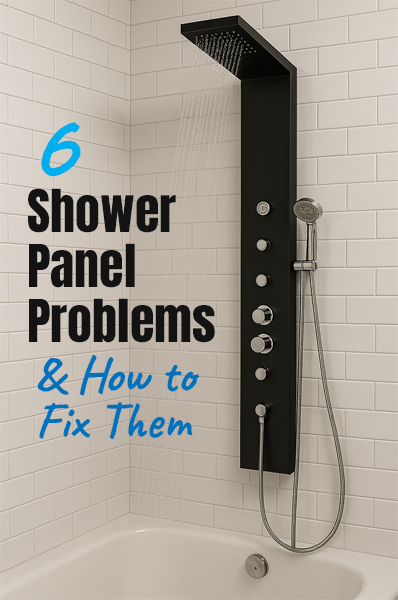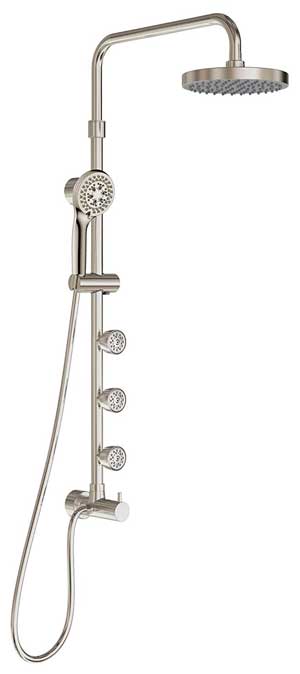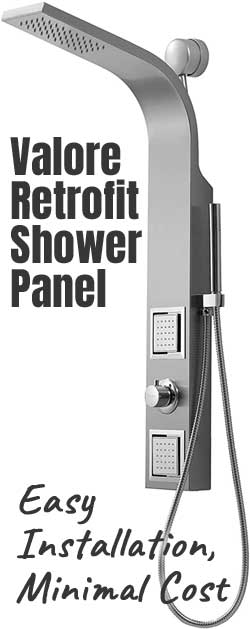
Upgrading to a full-featured shower panel can feel like stepping into a spa—until the problems start. From awkward installations to weak water pressure, there are a few things no one tells you before you buy.
Here’s a breakdown of the six most common issues people run into, plus the exact fixes and workarounds that make them easy to overcome.
1. Poor Water Pressure
What Happens:
Multi-jet panels look great on paper, but when you turn them on with weak pressure, it’s a letdown. You may end up using only one function at a time.
Simple Fix:
Install a pressure-boosting shower head or pump upstream of the panel, or a combo system with rainshower and handheld spray wand that you can enjoy even if you have low water pressure.
Checklist:
- ✅ Test your home’s PSI (target: 45–60+ PSI)
- ✅ Clean your filters and aerators regularly
- ✅ Look for “low pressure optimized” models
Pro Tip: Models with fewer simultaneous jets work better in older homes or apartments.
Pros:
✔ Better experience without replacing plumbing
Cons:
✘ May not work with gravity-fed systems without a pump
2. Complicated Installation
What Happens:
Panels often require re-routing plumbing or working behind tiled walls—not ideal for renters or DIYers.
Easy Workaround:
Choose a surface-mounted panel that attaches to your existing shower arm.
Step-by-Step DIY:
- Remove your existing showerhead
- Wrap the threads with plumber’s tape
- Screw in the mounting bracket
- Hang and connect your panel
- Turn on the water and test
Bonus: No wall damage, no permits, no pro plumber.
3. Temperature Fluctuations
What Happens:
Some panels don’t include a thermostatic mixer, so the temperature jumps when other water sources are used in your home.
Best Solution:
Upgrade to a panel with a built-in thermostatic valve or install a thermostatic mixing valve before the panel.
Example Fix:
- A thermostatic valve lets you lock in your ideal temp even if someone flushes a toilet.
Pros:
✔ No more cold or scalding surprises
Cons:
✘ Slightly higher upfront cost
4. Incompatible With Small Showers
What Happens:
Some panels are just too bulky for compact stalls or over-tub setups. The jets hit the walls instead of you.
Space-Saving Tip:
Choose a slim vertical design with an overhead and handheld sprayer only.
Checklist for Tight Spaces:
- ✅ Less than 6” deep
- ✅ Integrated diverter valve
- ✅ Mounts flush to wall
- ✅ Includes adjustable-height features
Real-World Pick: Retrofit stainless steel panels work great above standard tubs.
5. Hard Water and Clogged Jets
What Happens:
If you live in a hard water area, calcium buildup in jets can ruin the spray pattern within months.
How to Solve It:
Use a shower filter and clean the jets monthly with vinegar.
Quick Tutorial:
- Remove the panel’s nozzles or unscrew the faceplate
- Soak in a vinegar solution for 30 minutes
- Rinse and reinstall
Alternative: Look for rub-clean silicone jets that let you wipe away buildup with a finger.
6. Not Enough Hot Water
What Happens:
Multiple jets running at once = hot water drains fast.
Smart Fix:
- Set your water heater to 120°F–125°F
- Use a staggered spray routine—one feature at a time
- Consider a tankless heater if multiple people use the shower daily
Pro Tip: Use a panel with an eco-mode or individual control knobs to isolate jets.
Pros:
✔ Save energy and water
Cons:
✘ May require a few behavior tweaks
Final Thought
Don’t let small issues stop you from enjoying a full-body spa experience at home. Whether you’re dealing with low pressure or lack of space, there’s a simple way to get the upgrade without the headache. Choose smart, install wisely, and make sure your shower works for you—not against you.




